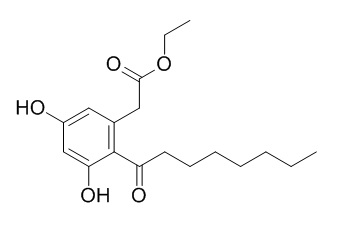Cytosporone B
Cytosporone B is a naturally occurring agonist for Nur77, it also is a Salmonella pathogenicity island 1 (SPI-1)-inhibitor, it may have potential in drug development against antibiotic-resistant Salmonella. Cytosporone B can elevate blood glucose levels in fasting C57 mice, an effect that is accompanied by induction of multiple genes involved in gluconeogenesis. Cytosporone B can inhibit transforming growth factor-b (TGF-β)-induced contraction of human corneal fibroblasts (HCFs), likely as a result of its attenuation of the up-regulation of α-SMA expression.
Inquire / Order:
manager@chemfaces.com
Technical Inquiries:
service@chemfaces.com
Tel:
+86-27-84237783
Fax:
+86-27-84254680
Address:
1 Building, No. 83, CheCheng Rd., Wuhan Economic and Technological Development Zone, Wuhan, Hubei 430056, PRC
Providing storage is as stated on the product vial and the vial is kept tightly sealed, the product can be stored for up to
24 months(2-8C).
Wherever possible, you should prepare and use solutions on the same day. However, if you need to make up stock solutions in advance, we recommend that you store the solution as aliquots in tightly sealed vials at -20C. Generally, these will be useable for up to two weeks. Before use, and prior to opening the vial we recommend that you allow your product to equilibrate to room temperature for at least 1 hour.
Need more advice on solubility, usage and handling? Please email to: service@chemfaces.com
The packaging of the product may have turned upside down during transportation, resulting in the natural compounds adhering to the neck or cap of the vial. take the vial out of its packaging and gently shake to let the compounds fall to the bottom of the vial. for liquid products, centrifuge at 200-500 RPM to gather the liquid at the bottom of the vial. try to avoid loss or contamination during handling.
Antioxidants (Basel).2021, 10(11):1831.
Sci Rep. 2018, 10590
Horticulturae2024, 10(4), 382.
Sci. Rep.2015, 14-23
Evidence-based Compl.&Alternative Med.2023, 5417813
Sichuan Agricultural University2023, 4630743.
Jurnal Ilmu Pertanian Indonesia2023, 28(4):525-533.
Prev Nutr Food Sci.2024, 29(4):466-473.
Asian Journal of Chemistry2014, 26(8):2425
Korean J. Medicinal Crop Sci.2023, 31(6):388-395.
Related and Featured Products
Antimicrobial Agents & Chemotherapy, 2013 , 57 (5) :2191-8.
Cytosporone B, an Inhibitor of the Type III Secretion System of Salmonella enterica Serovar Typhimurium[Reference:
WebLink]
METHODS AND RESULTS:
In this study, we identified several analogs of Cytosporone B (Csn-B) that strongly block the secretion of Salmonella pathogenicity island 1 (SPI-1)-associated effector proteins, without affecting the secretion of flagellar protein FliC in vitro. Csn-B and two other derivatives exhibited a strong inhibitory effect on SPI-1-mediated invasion to HeLa cells, while no significant toxicity to bacteria was observed. Nucleoid proteins Hha and H-NS bind to the promoters of SPI-1 regulator genes hilD, hilC, and rtsA to repress their expression and consequently regulate the expression of SPI-1 apparatus and effector genes. We found that Csn-B upregulated the transcription of hha and hns, implying that Csn-B probably affected the secretion of effectors through the Hha–H-NS regulatory pathway.
CONCLUSIONS:
In summary, this study presented an effective SPI-1 inhibitor, Csn-B, which may have potential in drug development against antibiotic-resistant Salmonella.
Nat Chem Biol. 2008 Sep;4(9):548-56.
Cytosporone B is an agonist for nuclear orphan receptor Nur77.[Pubmed:
18690216 ]
Nuclear orphan receptor Nur77 has important roles in many biological processes. However, a physiological ligand for Nur77 has not been identified.
METHODS AND RESULTS:
Here, we report that the octaketide Cytosporone B (Csn-B) is a naturally occurring agonist for Nur77. Csn-B specifically binds to the ligand-binding domain of Nur77 and stimulates Nur77-dependent transactivational activity towards target genes including Nr4a1 (Nur77) itself, which contains multiple consensus response elements allowing positive autoregulation in a Csn-B-dependent manner. Csn-B also elevates blood glucose levels in fasting C57 mice, an effect that is accompanied by induction of multiple genes involved in gluconeogenesis. These biological effects were not observed in Nur77-null (Nr4a1-/-) mice, which indicates that Csn-B regulates gluconeogenesis through Nur77. Moreover, Csn-B induced apoptosis and retarded xenograft tumor growth by inducing Nur77 expression, translocating Nur77 to mitochondria to cause cytochrome c release.
CONCLUSIONS:
Thus, Csn-B may represent a promising therapeutic drug for cancers and hypoglycemia, and it may also be useful as a reagent to increase understanding of Nur77 biological function.
Investigative Ophthalmology & Visual Science, 2016, 57(12):2363.
Cytosporone B inhibits the TGF-β–induced expression of a–smooth muscle actin and contractility in human corneal fibroblasts.[Reference:
WebLink]
Cytosporone B (CsnB) is an antagonist for the nuclear receptor transcription factor NR4A1, known as Nur77, which contributes to the regulation of apoptosis and glucose homeostasis. Recently, it is reported that NR4A1 is related to tissue scarring by regulating transforming growth factor–b (TGF-β) signaling.
METHODS AND RESULTS:
To investigate the role of NR4A1 in human corneal fibroblasts (HCFs), we examined the effects of CsnB on the expression of a–smooth muscle actin (α-SMA) and contractility in these cells induced by stimulation with TGF-β. Cytosporone B inhibited TGF-β–induced contraction of HCFs, likely as a result of its attenuation of the up-regulation of α-SMA expression.
CONCLUSIONS:
Our results suggest that NR4A1 mediates these effects of TGF-β in HCFs, and that CsnB warrants further investigation as a potential therapeutic modulator of corneal stromal contraction and scarring.



